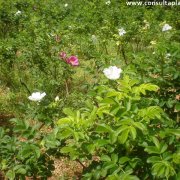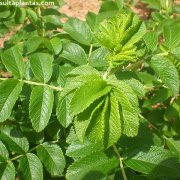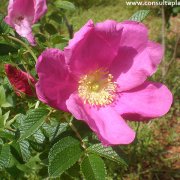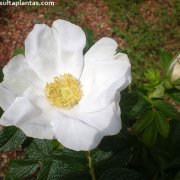Care of the shrub Rosa canina or Dog rose |
|
The genus Rosa, family Rosaceae, comprises 100 species of thorny shrubs native to Asia. Some species are: Rosa canina, Rosa banksiae, Rosa damascena, Rosa moschata, Rosa gallica, Rosa californica, Rosa wichuraiana. Common name: Dog rose. This species is native to Europe, northwest Africa, and western Asia. They are bushy or climbing plants that reach 3 meters (9.84 feet) in height. They have oval, serrated-edged, bright green leaves. The showy flowers can be pink or white and contrast with the foliage. They bloom from late spring to mid-summer. The decorative edible red berries have medicinal properties. Dog rose is used to form hedges, in bushy groups, in undergrowth and in dry areas of the garden. It's ideal for Mediterranean and Atlantic coastal gardens. With the fruits jams, wines and syrups are prepared. Rosa canina grows in full sun, semi-shade, and shaded exposures. It resists frosts down to -20 ºC (-4 ºF) and the heat of the Mediterranean summer. Dog rose can grow in poor soils but prefers that they contain organic matter and drain well. Water regularly, waiting for the surface layer of the substrate to dry (4 cm/1.57"). In winter reduce watering. Fertilize in autumn with manure or compost and in spring once with mineral fertilizer. Prune in late winter to strengthen the plant and keep it compact. Rosa canina is a resistant plant to the usual pests and diseases. Galls may appear on the leaves produced by small wasps but do not affect the health of the plant. Dog rose is propagated from seeds sown in spring previously soaked in warm water for at least 24 hours. |
Images of the shrub Rosa canina or Dog rose |
Find plants
Rosa canina or Dog rose | Care and Growing
© 2025 FavThemes



